- Submissions

Full Text
Archives of Blood Transfusion & Disorders
Assessment of Some Haemostasis System Blood Indicators among the Elderly Attending a tertiary Health Institution in Nigeria
Benjamin O Eledo1,2, Sylvester C Izah3* and Okezie C Okamgba4
1 Department of Medical Laboratory Science, Madonna University, Nigeria
2 Department of Haematology and Blood Transfusion, Federal Medical Centre, Nigeria
3 Department of Biological Sciences, Niger Delta University, Nigeria
4 Department of Medical Laboratory Science, Abia State University Uturu, Nigeria
*Corresponding author: Sylvester C Izah, Department of Biological Sciences, Faculty of Science, Niger Delta University, Wilberforce Island, Bayelsa State, Nigeria
Submission: May 21, 2018; Published: June 13, 2018
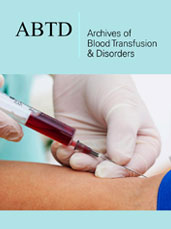
ISSN 2578-0239 Volume1 Issue3
Abstract
The effects of ageing on some haemostatic indicators were investigated among a population attending a tertiary health institution in Yenagoa, Bayelsa state, Nigeria. Blood samples were collected from 64 participants comprising 31 males and 33 females aged between 61-73 years attending the general out -patient clinic of the Federal Medical Centre Yenagoa, Bayelsa state, Nigeria. Furthermore, 20 young people between 18-30 years were used as controls. The haemostatic indicators viz: pro-thrombin time, activated partial thromboplastin time and platelets counts were evaluated following standard methods. The mean results for elderly and control subjects were 15.07 seconds and 11.89 seconds, respectively for females and 15.54 seconds and 11.76 seconds, respectively for males (pro-thrombin time); 33.61 seconds and 29.05 seconds, respectively for females and 34.51 seconds and 28.50 seconds respectively, for males (activated partial thromboplastin time); 187.00x109/L and 274.81x109/L respectively, for females and186.94x109/L and 271.94x109/L respectively, for males (platelets count).
Statistically, there were significant variations (P< 0.001) between the elderly and control subjects. The pro-thrombin time, activated partial thromboplastin time showed a significant increase while blood platelets showed significant decline with ageing. This suggests possible by functioning of the haemostatic system. Therefore there is the need to monitor haemostatic system in elderly for effective management and possibly prevention of coagulation and thrombotic disorders.
keywords Blood disorder; Elderly; Coagulation; Haemostatic system; Thrombosis
Introduction
Haemostasis which means standing is a process of clot formation, that is, arresting bleeding arising from damaged blood vessel [1,2]. In humans excess loss of blood without stopping could lead to shock and possibly death [1,2]. According to Obeaguet et al. [1], Okoroiwuet et al. [2], Marieband Haelin [3], it’s the endothelial cells of intact vessels that prevent blood clotting with a heparin like molecule, and thrombo modul in prevents platelet aggregation with nitric oxide and prostacyclin. Typically when endothelia injury occurs, the cells stop secretion of coagulation and aggregation inhibitors and instead secrete Von Willbr and factors which initiate the maintenance of haemostasis after injury [1,2].
According to Obeaguet et al. [1], Okoroiwuet et al. [2], 3 major sequences occur during haemostasis including vascular spasm (leading to constriction of blood vessels causing less blood to loss), platelets plug formation (causing the blood platelet to stick together to form a temporary seal over the walls of blood vessels destroyed) and blood coagulation. Typically, haemostatic system is assessed based on some major parameters including pro* thrombin time, activated partial thromboplastin time and platelets counts [4-6]. Blood platelets are important in the maintenance of haemostasis at adequate amount, and they also involve in series of complex morphological and biochemical changes [7]. Alteration in blood platelets could lead to some complications such as thrombosis depending on the medical condition of the individual.
Furthermore, Pro-thrombin time, activated partial thromboplastin time are major coagulation parameters [4-6,8,9], and can be used to assess coagulopathy and monitor anticoagulant drug therapy [10]. Also, authors have variously indicated that coagulation blood indicators are used to determine the role of coagulation factors in extrinsic and intrinsic path ways [11-13]. Some basic coagulation parameters are used to ascertain the integrity of the blood coagulation system.
Ageing is growth from one stage to another. In human ageing has to do with the development of certain features such as hair in pubic region, broad chest by male and breast by women. Ageing could also lead to several physiological changes in the body and it could affect the several systems including cardiovascular, digestive, nervous, endocrine, skeletal, respiratory, decline in vision, hearing, and other sensory organs, regulatory mechanisms, some important organs such as kidney and causing changes in skin [14]. Ageing could also predispose the body to risk of multiple infection and decline in immunity level depending on medical condition of the individuals. For instance, the tendency to recover from certain diseases such as pneumonia is far higher in young adults compared to the elderly [14]. According to Sivroet et al. [15] ageing leads to decline in the ability of the immune system to produce antibodies that are required to fight infections.
In addition, the performance of certain vital organs such as heart, kidneys, brain, lungs shows a gradual decline with ageing over the life span [14]. Furthermore, the changes that is associated with ageing leads to senescence thereby contributing to decline of biological functions and of the ability to adapt to metabolic stress [14]. The authors further reported that physiological developments in humans is usually associated with psychological and behavioural changes, as well as changes involving social and economic factors.
Physiological changes tend to affect a lot of body condition. This also reflects on the haemostatic system. For instance, conditions such as hypertension, menstruation, pregnancy, exercise etc influence haemostatic system. Therefore, this study aimed at assessing blood platelets, pro-thrombin time and activated partial thromboplastin time among elderly attending Federal Medical centre, Yenagoa, Nigeria [15].
Materials and Methods
Study area
Yenagoa is the Bayelsa state capital. The state shares boundary with Rivers, Delta and Atlantic ocean. The area is within the sedimentary basin. Fishing is one of the major occupations of the natives of the areas. Civil service and business are also common in the region. The relative humidity and atmospheric temperature of the area is with the value of 50-95% and 28±5 °C, respectively previously reported with the Niger Delta region all year round [16-20].
Criteria for selection of subjects
a. Inclusion Criteria: 64 elderly individuals within the age of 61-73 years comprising of 31 males and 33 females attending the general out-patient clinic of the Federal Medical Centre Yenagoa, Bayelsa state with informed consent participated in this study. Furthermore, 20 young people between 18-30 years were used as control.
b. Exclusion criteria: Elderly with known cases of clotting and bleeding disorders, hepatitis B and C, tuberculosis, diabetes, HIV1&2 and those that refused consent were excluded from the study.
Blood collection
The venipuncture method previously described by Eledo et al. [4-6]. Eledo [21] was employed for blood collection. About 5mls of blood was collected from each participant, and approximately 2.25mls of blood was dispensed into a plastic tube containing 0.25ml of tri-sodium citrate for pro-thrombin time and activated partial thromboplastin time analysis, while the remaining blood sample was dispensed into di potassium EDTA bottles containing 1.5mg/ml of blood of the anhydrous salt for platelets count analysis.
Laboratory analysis
The blood platelets were determined using Cronkit’s ammonium oxalate method. While the pro-thrombin time and activated partial thromboplastin time were analyzed using Kits with Lot Numbers: 52601004 and 52602002 respectively supplied by Agape Diagnostics Switzerland based on the method previously applied by Eledo et al. [5,6].
Statistical analysis
The resultant data were presented as mean±standard error, and significance difference was determined at α=0.05 based on Student‘t’ test using SPSS version 20 software
Result and Discussion
Table 1: Effect of aging on some haemostatic parameters in females.

Table 2: Effect of aging on some haemostatic parameters in females.

The haemostatic blood indicators of elderly females and males attending Federal Medical Centre, Yenagoa, Bayelsa state, Nigeria was presented in Table 1 & 2, respectively. The elderly and control subjects pro-thrombin time was 15.07 seconds and 11.89 seconds, respectively for females (Table 1), 15.54 seconds and 11.76 seconds, respectively for males (Table 2); the activated partial thromboplastin time was 33.61 seconds and 29.05 seconds, respectively for females (Table 1), 34.51 seconds and 28.50 seconds respectively, for males (Table 2); and blood platelets was 187.00x109/L and 274.81x109/L respectively, for females (Table 1), 186.94x109/L and 271.94x109/L respectively for males (Table 2). Statistically, there were significant variation (P< 0.001) between the elderly and control subjects for each of the parameters under study.
The significant variation inactivated partial thromboplastin time may be associated to decline in one or more of the intrinsic pathway clotting factors (viz: prekallikrein, high molecular weight kininogen, factor XII, XI, IX, and VIII)[2]. Also an increase in activated partial thromboplastin time and pro-thrombin time may be an indication of decline in the common pathway coagulation factor (factor X, V, and II) and /or defects in qualitative or quantitative fibrinogen due to ageing [2]. Furthermore, in women, menopause may cause a decline in haemostatic function. According to Okoroiwuet et al. [2], menopause in women may lead to significant elevation in ant thrombin III plasma level in coagulation system.
In the platelets counts observed in this study, there was a significant decline. Merlo-Pichet al. [22] & Okoroiwuet al. [2] the decline may be due to reduced sensitivity of specific inhibitor rotenone. The effects of ageing on platelets counts may be associated with the ageing process. Segal et al. [23] & Okoroiwu et al. [2] held the opinion that decline in platelets due to ageing could be related to decline in hematopoietic stem cell. Furthermore, Obeagu et al. [1] & Okoroiwu et al. [2] reported that coagulation reinforces platelets plug with fibrin threads (molecular glue) and at ageing there is heightening of coagulation enzyme activity.
The trends in this study viz: increased pro-thrombin time and activated partial thromboplastin time, and decline in blood platelet counts compared to control (younger individuals) is comparable to the findings of Okoroiwu et al. [2]. Typically, ageing causes an alteration in haemostatics balance, which could be associated to platelet activation, enhancement of certain clotting factor proteins, decline of the fibrinolytic system, and amendment of the endothelium and blood flow [24]. This could predispose the aged to thrombosis rather than bleeding [24].
Figure 1: Distribution of the effect of aging on some haemostatic parameters based on sex.

Based on sex, the female had slightly apparent higher value of pro-thrombin time, platelets count and lower value of activated partial thromboplastin time (Figure 1). Furthermore, pro thrombin time showed a dependent increase in males (Figure 2), activated partial thromboplastin time showed an elevation in value from 60-69 years and slight decline in 70 years and above in males (Figure 3). The platelets counts showed an elevation from 60-64 years to 65-69 years and a decline at 70years and above in males (Figure 4). In females, pro-thrombin time showed a dependent increase from 60-64 years to 65-69 years and slight decline in 70years and above years (Figure 5), activated partial thromboplastin time showed an elevation with increase in age (Figure 6). The platelets counts showed a decline at 65-69 years and an elevation at 70years and above (Figure 7).
Figure 2: Age distribution in males for pro-thrombin time.
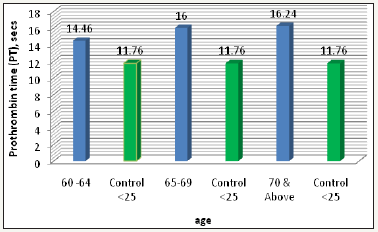
Figure 3: Age distribution in males for activated partial thromboplastin time.
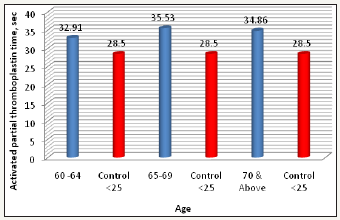
Figure 4: Age distribution in males for platelets count.
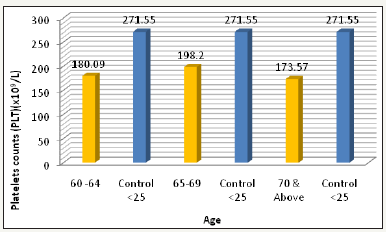
Figure 5: Age distribution in females for pro-thrombin time.
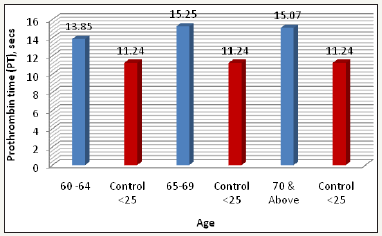
Figure 6: Age distribution in females for activated partial thromboplastin time.
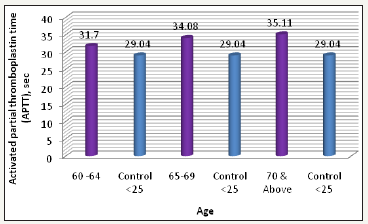
Figure 7: Age distribution in females for platelets.
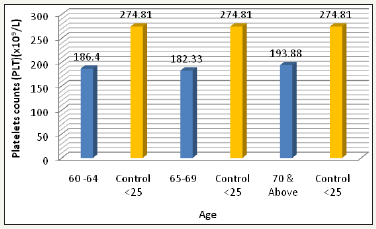
This trend is not in accordance with the findings of Okoroiwu et al. [2]. The slight variation may be associated to possible unknown underlining medical health status since ageing predisposes the body to risk of multiple infections leading to varying physiological functions. Furthermore, Kruse Jarres [24] reported that variation in renal function, amendment in immune regulation, and a multitude of other disease processes can put one at risk of acquired bleeding disorders.
Conclusion
Ageing affects several physiological functions of the body there by leading to decline in immune system response and making the body to be susceptible to multiple infections. This study investigated the effect of ageing on some haemostatic parameters. Results showed a significant elevation in pro-thrombin time and activated partial thromboplastin time, and decline in blood platelet counts. This suggests that the ageing process predisposes the patients to risk of coagulation and thrombotic disorders. Therefore, adequate care should be maintained when handling the elderly patients
References
- Obeagu EI, Nwachukwu BN, Daniel Igwe G (2015) Haemostasis and aging: a review. International Journal of Current Research in Biosciences and Plant Biology 2(10): 68-77.
- Okoroiwu IL, Obeagu EI, Elemchukwu Q, Ochei KC (2014) Investigation of haemostatic status in the elderly male and female using some parameters. IOSR Journal of Pharmacy and Biological Sciences 9(5): 88- 92.
- Marieb E,Haelin K (2010) Human anatomy and physiology. San Francisco Benjamin Cummings 649-650.
- Eledo BO, Igwe R, Okamgba OC, Izah SC (2017) Effect of exercise on some haemostatic parameters among students in a tertiary educational institution in Nigeria. American Journal of Health Research 5(5): 145- 148.
- Eledo BO, Nwoga MI, Okamgba OC, Izah SC (2017) Assessment of some haemostatic parameters among diabetes mellitus patients in bayelsa state: a case study at the federal medical centre, yenagoa. European Journal of Clinical and Biomedical Sciences 3(5): 91-96.
- Eledo BO, Allagoa DO, Ihedioha AU, Dunga KE, Izah SC (2017) Evaluation of some haematological parameters among post-menopausal women in bayelsa state, nigeria: a case study of patients attending federal medical centre, yenagoa. American Journal of Laboratory Medicine 2(6): 132- 136.
- Nwovu AI, Obeagu EI, Obeagu GU, Nnadiekwe OI (2018) Evaluation of platelet and prothrombin time in hypertensive patients attending clinic in federal teaching hospital abakaliki. Open Acc Blood Res Transfus J 1(5): 555571.
- Limijadi EKS, Suromo LB, Budiwiyono I (2016) Prothrombine and activated partial thromboplastin time are prolonged in hepatic cirrhosis. Universa Medicina 35(1): 26-32.
- Korte W, Clarke S, Lefkowitz JB (2000) Short activated partial thromboplastin times are related to increased thrombin generation and an increased risk for thromboembolism. Am J Clin Pathol 113(1): 123- 127.
- Ndakotsu MA, Hassan A, Musa AU, Gusau YB, Kwaifa IK (2013) Effect of plasma storage on prothrombin time and activated partial thromboplastin time at a Nigerian public laboratory. Sahel Med J 16(1): 1-4.
- Abdollahi A, Shoar N, Shoar S, Rasoulinejad M (2013) Extrinsic and intrinsic coagulation pathway, fibrinogen serum level and platelet count in HIV positive patients. Acta Med Iran 51(7): 472-476.
- Miljic D, Miljic P, Doknic M, Pekic S, Djurovic M, et al. (2006) Changes in prothrombin and activated partial thromboplastin time during replacement therapy with human recombinant growth hormone in growth hormone deficient adults. Horm Hormones (Athens) 5(3): 187- 191.
- Jiskani AS, Memon S, Naseem L (2017) Prothrombin Time (PT), Activated partial thromboplastin time (aptt) and international normalized ratio (inr) as predictive factors of coagulopathy in newly diagnosed hypertensive patients. Hematol Transfus Int J 4(3): 00086.
- Shock NW (2018) Human gaining.
- Sivro A, Lajoie J, Kimani J, Jaoko W, Plummer FA, et al. (2013) Age and menopause affect the expression of specific cytokines/chemokines in plasma and cervical lavage samples from female sex workers in Nairobi, Kenya. Immun Ageing 10(1): 42.
- Izah SC, Bassey SE, Ohimain EI (2017) Assessment of heavy metal in cassava mill effluent contaminated soil in a rural community in the Niger Delta region of Nigeria. EC Pharmacology and Toxicology 4(5): 186-201.
- Izah SC, Bassey SE, Ohimain EI (2017) Assessment of pollution load indices of heavy metals in cassava mill effluents contaminated soil: a case study of small-scale cassava processing mills in a rural community of the Niger Delta region of Nigeria. Bioscience Methods 8(1): 1-17.
- Izah SC, Bassey SE, Ohimain EI (2017) Geo-accumulation index, enrichment factor and quantification of contamination of heavy metals in soil receiving cassava mill effluents in a rural community in the Niger Delta region of Nigeria. Molecular Soil Biology 8(2): 7-20.
- Izah SC, Bassey SE, Ohimain EI (201) Ecological risk assessment of heavy metals in cassava mill effluents contaminated soil in a rural community in the Niger Delta Region of Nigeria. Molecular Soil Biology 9(1): 1-11.
- Izah SC, Aigberua AO (2017) Assessment of microbial quality of cassava mill effluents contaminated soil in a rural community in the niger delta, Nigeria. EC Microbiology 13(4): 132-140.
- Eledo BO, Igwe MU, Izah SC (2018) Evaluation of total white blood cells and cluster of differentiation 4 cells among post -menopausal women in allele, Nigeria. Modern Research in Inflammation 7(2): 21-29.
- Merlo Pich V, Schmaier A, James GE (1996) Population study of platelet and aging. Br Med Bull 22: 180-185.
- Segal JB, Molitermo AR (2006) Platelet count differ by ethnicity sex, and age in united states. Annals of Epidemiology 16(2): 123-130.
- Kruse Jarres R (2015) Acquired bleeding disorders in the elderly. Hematology Am Soc Hematol Educ Program 231- 236.
© 2018 Andrey Belousov. This is an open access article distributed under the terms of the Creative Commons Attribution License , which permits unrestricted use, distribution, and build upon your work non-commercially.
 a Creative Commons Attribution 4.0 International License. Based on a work at www.crimsonpublishers.com.
Best viewed in
a Creative Commons Attribution 4.0 International License. Based on a work at www.crimsonpublishers.com.
Best viewed in 







.jpg)






























 Editorial Board Registrations
Editorial Board Registrations Submit your Article
Submit your Article Refer a Friend
Refer a Friend Advertise With Us
Advertise With Us
.jpg)






.jpg)














.bmp)
.jpg)
.png)
.jpg)










.jpg)






.png)

.png)



.png)






